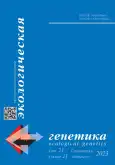Modification of agricultural traits in cultivated varieties of barley and wheat
- Authors: Timonova E.M.1, Kiseleva A.A.1, Berezhnaia A.A.1, Nesterov M.A.1, Adonina I.G.1, Kochetov A.V.1, Salina E.A.1
-
Affiliations:
- Institute of Cytology and Genetics, Siberian Branch of Russian Academy of Sciences
- Issue: Vol 21 (2023): Спецвыпуск
- Pages: 24-25
- Section: Genetically modified organism. The Нistory, Achivements, Social and Environmental Riscs
- Submitted: 09.08.2023
- Accepted: 26.08.2023
- Published: 04.12.2023
- URL: https://journals.eco-vector.com/ecolgenet/article/view/568184
- DOI: https://doi.org/10.17816/ecogen568184
- ID: 568184
Cite item
Full Text
Abstract
CRISPR/Cas technology makes it possible to induce mutations at defined positions. In breeding-oriented research, this opens up exciting opportunities for the targeted improvement of many agricultural crops. Wheat and barley are among the most important cereals in the world. However, the transformation poses a particular challenge for cereals and is strongly genotype dependent. This is because agrobacteria, which is mostly used for delivering the CRISPR/Cas system, have a limited compatibility with these non-host plants. Transformation of wheat is additionally difficult due to the large genome size and polyploidy.
Besides obtaining improved genotypes, the object of the current study was to optimize the method of genomic editing based on the CRISPR/Cas system using particle bombardment for non-model varieties of barley and wheat. In barley, we targeted the Nud gene that controls hulled/naked phenotype of the grain. Since the regeneration rate remains an issue for the cultivated cultivars, we used the JD633 vector that carries the GRF4-GIF1 chimera to increase the efficiency of regeneration. We obtained five T0 plants, carrying mutations. In wheat, targeting Ppd-1 genes that control photoperiod-dependent floral induction results in Cas9-induced mutations in 52 of 210 T0 plants. The developed collection of wheat plants with different new alleles of Ppd-D1 and Ppd-B1 genes is being studied for the expression under short day conditions and the effect on the vegetation period.
Thus, we have obtained plants of the cultivated varieties of barley and wheat with edited agronomically important genes, using the improved protocols of biolistic transformation.
This work was done within the framework of State Assignment Kurchatov Genomic Center of ICG SB RAS (No. 075-15-2019-1662).
Keywords
Full Text
CRISPR/Cas technology makes it possible to induce mutations at defined positions. In breeding-oriented research, this opens up exciting opportunities for the targeted improvement of many agricultural crops. Wheat and barley are among the most important cereals in the world. However, the transformation poses a particular challenge for cereals and is strongly genotype dependent. This is because agrobacteria, which is mostly used for delivering the CRISPR/Cas system, have a limited compatibility with these non-host plants. Transformation of wheat is additionally difficult due to the large genome size and polyploidy.
Besides obtaining improved genotypes, the object of the current study was to optimize the method of genomic editing based on the CRISPR/Cas system using particle bombardment for non-model varieties of barley and wheat. In barley, we targeted the Nud gene that controls hulled/naked phenotype of the grain. Since the regeneration rate remains an issue for the cultivated cultivars, we used the JD633 vector that carries the GRF4-GIF1 chimera to increase the efficiency of regeneration. We obtained five T0 plants, carrying mutations. In wheat, targeting Ppd-1 genes that control photoperiod-dependent floral induction results in Cas9-induced mutations in 52 of 210 T0 plants. The developed collection of wheat plants with different new alleles of Ppd-D1 and Ppd-B1 genes is being studied for the expression under short day conditions and the effect on the vegetation period.
Thus, we have obtained plants of the cultivated varieties of barley and wheat with edited agronomically important genes, using the improved protocols of biolistic transformation.
This work was done within the framework of State Assignment Kurchatov Genomic Center of ICG SB RAS (No. 075-15-2019-1662).
About the authors
Ekaterina M. Timonova
Institute of Cytology and Genetics, Siberian Branch of Russian Academy of Sciences
Email: eegorova@bionet.nsc.ru
ORCID iD: 0000-0002-3341-5080
Russian Federation, Novosibirsk
Antonina A. Kiseleva
Institute of Cytology and Genetics, Siberian Branch of Russian Academy of Sciences
Email: antkiseleva@bionet.nsc.ru
ORCID iD: 0000-0002-3725-8596
Russian Federation, Novosibirsk
Alina A. Berezhnaia
Institute of Cytology and Genetics, Siberian Branch of Russian Academy of Sciences
Email: al.berezhnaya1@gmail.com
ORCID iD: 0009-0002-6848-3291
Russian Federation, Novosibirsk
Mikhail A. Nesterov
Institute of Cytology and Genetics, Siberian Branch of Russian Academy of Sciences
Email: mikkanestor@bionet.nsc.ru
ORCID iD: 0000-0001-5407-2411
Russian Federation, Novosibirsk
Irina G. Adonina
Institute of Cytology and Genetics, Siberian Branch of Russian Academy of Sciences
Email: adonina@bionet.nsc.ru
ORCID iD: 0000-0002-8460-6119
Russian Federation, Novosibirsk
Aleksey V. Kochetov
Institute of Cytology and Genetics, Siberian Branch of Russian Academy of Sciences
Email: ak@bionet.nsc.ru
ORCID iD: 0000-0001-7221-9886
Russian Federation, Novosibirsk
Elena A. Salina
Institute of Cytology and Genetics, Siberian Branch of Russian Academy of Sciences
Author for correspondence.
Email: salina@bionet.nsc.ru
ORCID iD: 0000-0001-8590-847X
Russian Federation, Novosibirsk
References
Supplementary files










